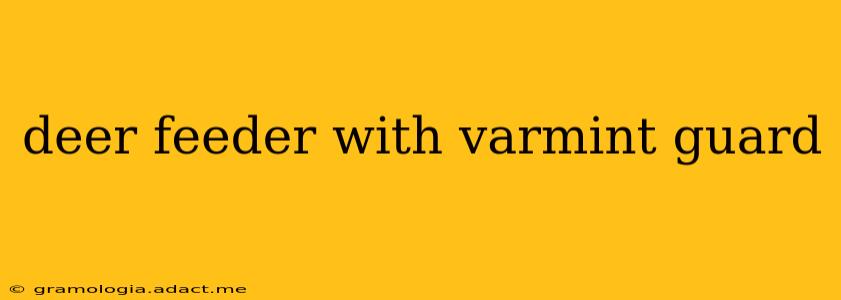Feeding deer can be a rewarding experience, allowing you to observe these majestic creatures up close and contribute to their well-being, especially during harsh winters. However, providing supplemental feed also attracts unwanted guests: raccoons, squirrels, and other varmints that can quickly deplete your feed supply and even damage your feeder. This is where a deer feeder with a varmint guard becomes essential. This comprehensive guide will explore the benefits, types, and considerations for choosing the right feeder to protect your investment and ensure your deer get the nourishment they need.
What is a Varmint Guard?
A varmint guard is a crucial component of a deer feeder designed to prevent smaller animals from accessing the feed while allowing deer to feed freely. These guards utilize various mechanisms to deter unwanted critters, ranging from simple baffles to complex, rotating systems. The effectiveness of a varmint guard hinges on its design and placement, ensuring it adequately restricts access for smaller animals while remaining accessible to deer.
Types of Deer Feeders with Varmint Guards
Several types of deer feeders incorporate varmint guards, each with its own advantages and disadvantages:
1. Gravity Feeders with Baffles:
These feeders utilize gravity to dispense feed, with strategically placed baffles or cones that create obstacles for smaller animals. The simple design makes them relatively inexpensive, but their effectiveness can vary depending on the design and the persistence of the varmints.
2. Spinner Feeders with Varmint Guards:
Spinner feeders use a rotating mechanism to dispense feed, often incorporating a cage or baffle system around the dispensing area. This design is generally more effective at keeping out smaller animals because it prevents them from easily reaching the feed. However, they are typically more expensive than gravity feeders.
3. Platform Feeders with Varmint Guards:
Platform feeders offer a large, flat surface for dispensing feed. Varmint guards for these feeders often consist of a raised platform, a covered enclosure, or a combination of both. These can be effective but may require more frequent refilling.
4. Tripod Feeders with Varmint Guards:
Tripod feeders are elevated, providing a secure location for storing and dispensing feed, often incorporating varmint guards in the form of cone-shaped baffles or protective cages. The height alone can deter some varmints but combining this with a guard ensures better protection.
How to Choose the Right Deer Feeder with a Varmint Guard
Choosing the right deer feeder involves several key considerations:
- Capacity: Consider the number of deer you're feeding and the frequency of refills. Larger capacity feeders require less frequent maintenance.
- Material: Durable materials such as metal are more resistant to damage from varmints and the elements.
- Ease of Refilling: Choose a feeder that's easy to refill without requiring significant effort.
- Durability: Look for a feeder that can withstand harsh weather conditions and the efforts of persistent varmints.
- Type of Varmint Guard: The effectiveness of the guard is crucial. Consider a design that is proven to deter common varmints in your area.
What size feeder is best for deer?
The optimal size of a deer feeder depends on several factors, including the number of deer you intend to feed, the frequency of refills you're comfortable with, and the size and type of deer in your area. There isn't a one-size-fits-all answer. A feeder that's too small will need frequent refills, while one that's too large could lead to waste. Research local regulations and consider the typical deer population size in your area.
What type of feed should I use in my deer feeder?
The best type of feed for a deer feeder varies based on the time of year and the deer’s nutritional needs. During the winter, providing high-energy feed like corn is beneficial. However, a balanced approach throughout the year incorporates a variety of feed sources for optimal health. Consult with local wildlife experts or game wardens for recommendations specific to your area and season.
How often should I refill my deer feeder?
Refilling frequency is contingent on the feeder's capacity, the number of deer, and the type of feed used. Regularly check the feeder's feed level and replenish as needed to ensure a consistent food source. Avoid letting the feeder become completely empty, as this can encourage aggressive competition among the deer.
How much feed should I put in my deer feeder?
Overfilling a deer feeder can lead to waste and attract unwanted animals. It's crucial to place only the appropriate amount of feed required to sustain the deer population without excessive leftovers. Observe deer feeding patterns and adjust your refill amount accordingly. Start small and gradually increase as needed.
Choosing a deer feeder with a robust varmint guard is a crucial step in ensuring the success of your deer feeding efforts. By carefully considering the factors outlined above and selecting a high-quality feeder, you can provide a reliable food source for deer while minimizing the impact of unwanted guests. Remember to always check local regulations before setting up any deer feeders.
